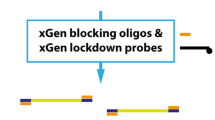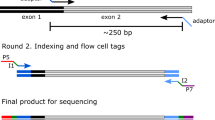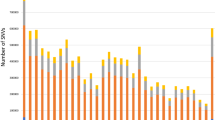Abstract
Gene doping has raised concerns in human and equestrian sports and the horseracing industry. There are two possible types of gene doping in the sports and racing industry: (1) administration of a gene-doping substance to postnatal animals and (2) generation of genetically engineered animals by modifying eggs. In this study, we aimed to identify genetically engineered animals by whole-genome resequencing (WGR) for gene-doping control. Transgenic cell lines, in which the erythropoietin gene (EPO) cDNA form was inserted into the genome of horse fibroblasts, were constructed as a model of genetically modified horse. Genome-wide screening of non-targeted transgenes was performed to find structural variation using DELLY based on split-read and paired-end algorithms and Control-FREEC based on read-depth algorithm. We detected the EPO transgene as an intron deletion in the WGR data by the split-read algorithm of DELLY. In addition, single-nucleotide polymorphisms and insertions/deletions artificially introduced in the EPO transgene were identified by WGR. Therefore, genome-wide screening using WGR can contribute to gene-doping control even if the targets are unknown. This is the first study to detect transgenes as intron deletions for gene-doping detection.
This is a preview of subscription content, access via your institution
Access options
Subscribe to this journal
Receive 12 print issues and online access
$259.00 per year
only $21.58 per issue
Buy this article
- Purchase on Springer Link
- Instant access to full article PDF
Prices may be subject to local taxes which are calculated during checkout


Similar content being viewed by others
Data availability
Sequencing data of transgenic cell lines will be provided upon request to the corresponding author because of gene doping control in the horseracing industry.
References
Neuberger EWI, Simon P. Gene and cell doping: the new frontier—beyond myth or reality. Med Sport Sci. 2017;62:91–106.
Brzeziańska E, Domańska D, Jegier A. Gene doping in sport—perspectives and risks. Biol Sport. 2014;31:251–9.
Martin NP, Myers P, Goulding E, Chen SH, Walker M, Porter TM, et al. Laser-assisted lentiviral gene delivery to mouse fertilized eggs. J Vis Exp. 2018;141:58327.
Eghbalsaied S, Kues WA. Development of a transposon-based technology for transfection of day 0 chicken embryos. Gene. 2020;730:144318.
Chandrashekran A, Casimir C, Dibb N, Readhead C, Winston R. Generating transgenic mice by lentiviral transduction of spermatozoa followed by in vitro fertilization and embryo transfer. Methods Mol Biol. 2016;1448:95–106.
Zakhartchenko V, Flisikowska T, Li S, Richter T, Wieland H, Durkovic M, et al. Cell-mediated transgenesis in rabbits: chimeric and nuclear transfer animals. Biol Reprod. 2011;84:229–37.
Filipiak WE, Hughes ED, Gavrilina GB, LaForest AK, Saunders TL. Next generation transgenic rat model production. Methods Mol Biol. 2019;2018:97–114.
Pellenz S, Phelps M, Tang W, Hovde BT, Sinit RB, Fu W, et al. New human chromosomal sites with “Safe Harbor” potential for targeted transgene insertion. Hum Gene Ther. 2019;30:814–28.
Kolli N, Lu M, Maiti P, Rossignol J, Dunbar GL. Application of the gene editing tool, CRISPR-Cas9, for treating neurodegenerative diseases. Neurochem Int. 2018;112:187–96.
Guo T, Feng YL, Xiao JJ, Liu Q, Sun XN, Xiang JF, et al. Harnessing accurate non-homologous end joining for efficient precise deletion in CRISPR/Cas9-mediated genome editing. Genome Biol. 2018;19:170.
Tozaki T, Ohnuma A, Takasu M, Kikuchi M, Kakoi H, Hirota KI, et al. Droplet digital PCR detection of the erythropoietin transgene from horse plasma and urine for gene-doping control. Genes. 2019;10:243.
Tozaki T, Gamo S, Takasu M, Kikuchi M, Kakoi H, Hirota KI, et al. Digital PCR detection of plasmid DNA administered to the skeletal muscle of a microminipig: a model case study for gene doping detection. BMC Res Notes. 2018;11:708.
Aoki K, Sugasawa T, Yanazawa K, Watanabe K, Takemasa T, Takeuchi Y, et al. The detection of trans gene fragments of hEPO in gene doping model mice by Taqman qPCR assay. PeerJ. 2020;8:e8595.
Haughan J, Jiang Z, Stefanovski D, Moss KL, Ortved KF, Robinson MA. Detection of intra-articular gene therapy in horses using quantitative real time PCR in synovial fluid and plasma. Drug Test Anal. 2020. https://doi.org/10.1002/dta.2785.
Zhang JJ, Xu JF, Shen YW, Ma SJ, Zhang TT, Meng QL, et al. Detection of exogenous gene doping of IGF-I by a real-time quantitative PCR assay. Biotechnol Appl Biochem. 2017;64:549–54.
Neuberger EW, Perez I, Le Guiner C, Moser D, Ehlert T, Allais M, et al. Establishment of two quantitative nested qPCR assays targeting the human EPO transgene. Gene Ther. 2016;23:330–9.
Baoutina A, Coldham T, Fuller B, Emslie KR. Improved detection of transgene and nonviral vectors in blood. Hum Gene Ther Methods. 2013;24:345–54.
Tozaki T, Kikuchi M, Kakoi H, Hirota KI, Nagat SI. A genome-wide association study for body weight in Japanese Thoroughbred racehorses clarifies candidate regions on chromosomes 3, 9, 15, and 18. J Equine Sci. 2017;28:127–34.
Gu J, MacHugh DE, McGivney BA, Park SD, Katz LM, Hill EW. Association of sequence variants in CKM (creatine kinase, muscle) and COX4I2 (cytochrome c oxidase, subunit 4, isoform 2) genes with racing performance in Thoroughbred horses. Equine Vet J Suppl. 2010;38:569–75.
Hill EW, Gu J, Eivers SS, Fonseca RG, McGivney BA, Govindarajan P, et al. A sequence polymorphism in MSTN predicts sprinting ability and racing stamina in thoroughbred horses. PLoS ONE. 2010;5:8645.
Tozaki T, Miyake T, Kakoi H, Gawahara H, Sugita S, Hasegawa T, et al. A genome-wide association study for racing performances in Thoroughbreds clarifies a candidate region near the MSTN gene. Anim Genet. 2010;41(Suppl 2):28–35.
Tozaki T, Ohnuma A, Kikuchi M, Ishige T, Kakoi H, Hirota KI, et al. Microfluidic quantitative PCR detection of 12 transgenes from horse plasma for gene-doping control. Genes. 2020;11:457.
Arboleda VA, Xian RR. An overview of DNA analytical methods. Methods Mol Biol. 2019;1897:385–402.
Yan Y, Yi G, Sun C, Qu L, Yang N. Genome-wide characterization of insertion and deletion variation in chicken using next generation sequencing. PLoS ONE. 2014;9:104652.
Neerman N, Faust G, Meeks N, Modai S, Kalfon L, Falik-Zaccai T, et al. A clinically validated whole genome pipeline for structural variant detection and analysis. BMC Genomics. 2019;20(Suppl 8):545.
Wade CM, Giulotto E, Sigurdsson S, Zoli M, Gnerre S, Imsland F, et al. Genome sequence, comparative analysis, and population genetics of the domestic horse. Science. 2009;326:865–7.
de Boer EN, van der Wouden PE, Johansson LF, van Diemen CC, Haisma HJ. A next-generation sequencing method for gene doping detection that distinguishes low levels of plasmid DNA against a background of genomic DNA. Gene Ther. 2019;26:338–46.
Li H, Durbin R. Fast and accurate short read alignment with Burrows-Wheeler transform. Bioinformatics. 2009;25:1754–60.
McLaren W, Gil L, Hunt SE, Riat HS, Ritchie GR, Thormann A, et al. The ensembl variant effect predictor. Genome Biol. 2016;17:122.
Rausch T, Zichner T, Schlattl A, Stütz AM, Benes V, Korbel JO. DELLY: structural variant discovery by integrated paired-end and split-read analysis. Bioinformatics. 2012;28:333–9.
Boeva V, Popova T, Bleakley K, Chiche P, Cappo J, Schleiermacher G, et al. Control-FREEC: a tool for assessing copy number and allelic content using next-generation sequencing data. Bioinformatics. 2012;28:423–5.
Kosugi S, Momozawa Y, Liu X, Terao C, Kubo M, Kamatani Y. Comprehensive evaluation of structural variation detection algorithms for whole genome sequencing. Genome Biol. 2019;20:117.
Kosugi S, Momozawa Y, Liu X, Terao C, Kubo M, Kamatani Y. Comprehensive evaluation of structural variation detection algorithms for whole genome sequencing. Genome Biol. 2019;20:117.
Ito T, Kawashima Y, Fujikawa T, Honda K, Makabe A, Kitamura K, et al. Rapid screening of copy number variations in STRC by droplet digital PCR in patients with mild-to-moderate hearing loss. Hum Genome Var. 2019;6:41.
International Stud Book Committee, Statistical Information Booklet, 2019:6–7. http://internationalstudbook.com/wp-content/uploads/2019/11/ISBC-Information-Booklet-2019-2016-to-2018-statistics.pdf.
Acknowledgements
We acknowledge Yuko Miyatake and Miyuki Kubokawa at Amelieff Corporation, Japan, for providing technical support and helpful discussions. We also thank Noriko Tanaka for her assistance with this study and the Japan Racing Association (JRA) for approving and supporting this study through a grant-in-aid (2017–2019).
Funding
This research was funded by the Japan Racing Association (2017–2019).
Author information
Authors and Affiliations
Contributions
TT and AO conceived and designed the experiments; TT and AO performed the experiments; MK, TI, HK, KH; KK and SN performed the animal experiments; MT, KN, and NT generated transgenic cells; KK provided critical comments and contributed to the discussion of the results and TT and AO drafted the paper. All authors reviewed and revised the paper.
Corresponding author
Ethics declarations
Conflict of interest
The authors declare that they have no conflict of interest.
Ethical approval
Animal experiments in this study were approved by the Animal Care Committee of the Equine Research Institute of the Japan Racing Association (approval number 19-9 on January 31, 2019). Animal experiments were conducted at the facilities of the Equine Research Institute, Japan Racing Association (Shimotsuke, Japan).
Additional information
Publisher’s note Springer Nature remains neutral with regard to jurisdictional claims in published maps and institutional affiliations.
Rights and permissions
About this article
Cite this article
Tozaki, T., Ohnuma, A., Takasu, M. et al. Detection of non-targeted transgenes by whole-genome resequencing for gene-doping control. Gene Ther 28, 199–205 (2021). https://doi.org/10.1038/s41434-020-00185-y
Received:
Revised:
Accepted:
Published:
Issue Date:
DOI: https://doi.org/10.1038/s41434-020-00185-y
This article is cited by
-
Control of gene doping in human and horse sports
Gene Therapy (2022)



